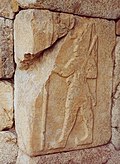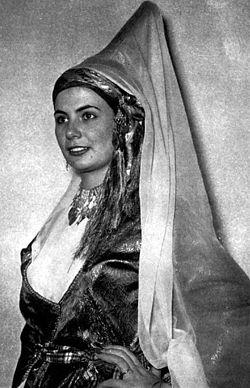Top Qs
Timeline
Chat
Perspective
Pointed hat
Type of headgear From Wikipedia, the free encyclopedia
Remove ads
Pointed hats have been a form of headgear of a wide range of cultures throughout history. Although often suggesting an ancient Indo-European tradition, they were also traditionally worn by women of Lapland, the Japanese, the Mi'kmaq people of Atlantic Canada, and the Huastecs of Veracruz and Aztec (e.g., as illustrated in the Codex Mendoza). The Kabiri of New Guinea have the diba, a pointed hat glued together.[1]

Remove ads
History
Summarize
Perspective
The conical hat is known to have existed as early as the Bronze Age in the Middle East, Eurasia, and Central Europe. Conical hats were recorded in ancient Egypt, especially when depicting Osiris and pharaohs, who emulated Osiris' iconography. Conical hats were also recorded by many Indo-European civilizations. Golden hats have been recorded in burial sites in Central Europe. The Scythians of the Eurasian steppes were noted for having pointed hats, often mentioned by other civilizations, such as in the DNa inscription on the tomb of Darius the Great. In Ancient Greece, the pilos was a common hat worn by travelers and infantrymen by the 5th century BCE. Popular among Burgundian noblewomen in the 15th century was a type of conical headgear now called a hennin.[2]
Iron Age
Textile analysis of the Tarim Mummies has shown some similarities to the Iron Age civilizations of Europe dating from 800 BCE, including woven twill and tartan patterns strikingly similar to tartans from Northern Europe. One unusual find was a distinctively pointed hat:
Yet another female – her skeleton found beside the remains of a man – still wore a terrifically tall, conical hat just like those we depict on witches riding broomsticks at Halloween or on medieval wizards intent at their magical spells.
— Elizabeth Wayland Barber[3]: 200
Pointed hats were also worn in ancient times by Saka (Scythians), and are shown on Hindu temples (as helmets and metal crowns) and in Hittite reliefs. As described by Herodotus, the name of the Scythian tribe of the tigrakhauda (Orthocorybantians) is a bahuvrihi compound literally translating to "people with pointed hats".[4][5]
Besides the Scythians, the Cabeiri as well as Odysseus are traditionally pictured wearing a Pilos, or woolen conical hat.[6]
- Ancient conical hats
- Scythian (Saka tigrakhauda) leader with the pointed cap typical of his people
- The Hallstatt culture Warrior of Hirschlanden wears a pointed hat or helmet.
- Relief in Hattusa, probably depicting Suppiluliuma II.
- Odysseus wearing a Pilos
- Prisoner with Phrygian cap (Roman statue from the 2nd century), Louvre
Middle Ages

The 13th-century Cumans commonly wore scythian style pointed hats,[7] and are reported to have fought wearing them.[8]
Originating from the Japanese Heian period, the kazaori eboshi (風折烏帽子) was worn by aristocrats to indicate rank. Still worn today for ceremonial purposes, this black[9] linen hat was used during a samurai's ceremony in attaining manhood.[10]

Medieval Jewish men wore distinctive headgear as required by European Christian authorities. This included the pointed Jewish hat (or "Judenhut") already worn by Jews, a piece of clothing probably imported from the Islamic world and perhaps before that from Persia.[11]
Popular among Burgundian noblewomen in the 15th century was a type of conical headgear now called a hennin.[2]
Remove ads
Modern times

Pointed hoods were used by various orders and Catholic lay confraternities for processions (e.g., the Semana Santa of Sevilla, who wore the Capirote).[12]
Pointed hats are still worn in the rural Louisiana Mardi Gras celebrations by the Cajuns, the Courir de Mardi Gras, where they are known as capuchons.[13]
The Ku Klux Klan has worn this headgear since its inception.[14]
Tall conical hats are common to traditional folk ceremonies in many parts of Europe, particularly at Carnival time. Examples can still be seen in Italy, Spain, and Bulgaria.[15]
The May Day hobby horses of Padstow and Minehead in southwest England have pointed hats with masks attached.[16][17][18]
Remove ads
Types
Remove ads
See also
References
Bibliography
External links
Wikiwand - on
Seamless Wikipedia browsing. On steroids.
Remove ads






























